With a colorful center and sesame flavored rice, vegetable kimbap makes a delicious snack or light lunch to eat at home, school, or work!
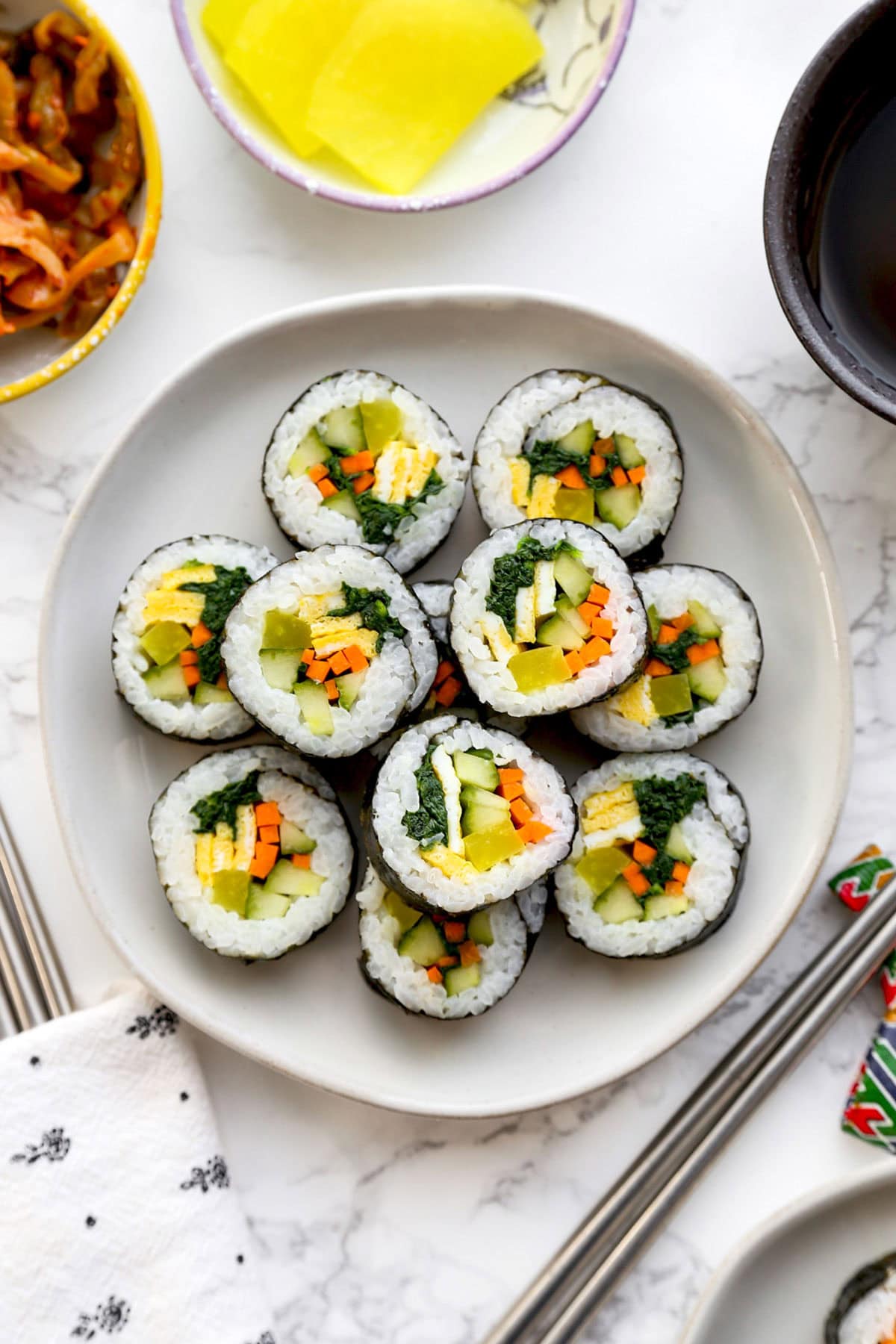
The first time I had kimbap was in Koreatown in Manhattan.
I was doing my usual grocery shopping at HMart and decided to stop somewhere in Koreatown for a quick bite to eat. I walked toward 5th avenue and past E-Mo, a tiny kimbap shop with only a carryout counter and a kitchen. Since I wasn’t too familiar with kimbap, my curiosity was piqued and in I went to order a couple of rolls.
It was nothing like what I expected to taste – the nutty sesame oil combined with the pickled flavors were right up my alley! And as someone who usually dips her rolls in soy sauce it was refreshing to eat these one without the need for additional seasoning.
My kimbap recipe is easy to follow and takes approximately 30 minutes to make. I’ve also taken lot of pictures so you can see exactly how to roll kimbap.
Table of contents
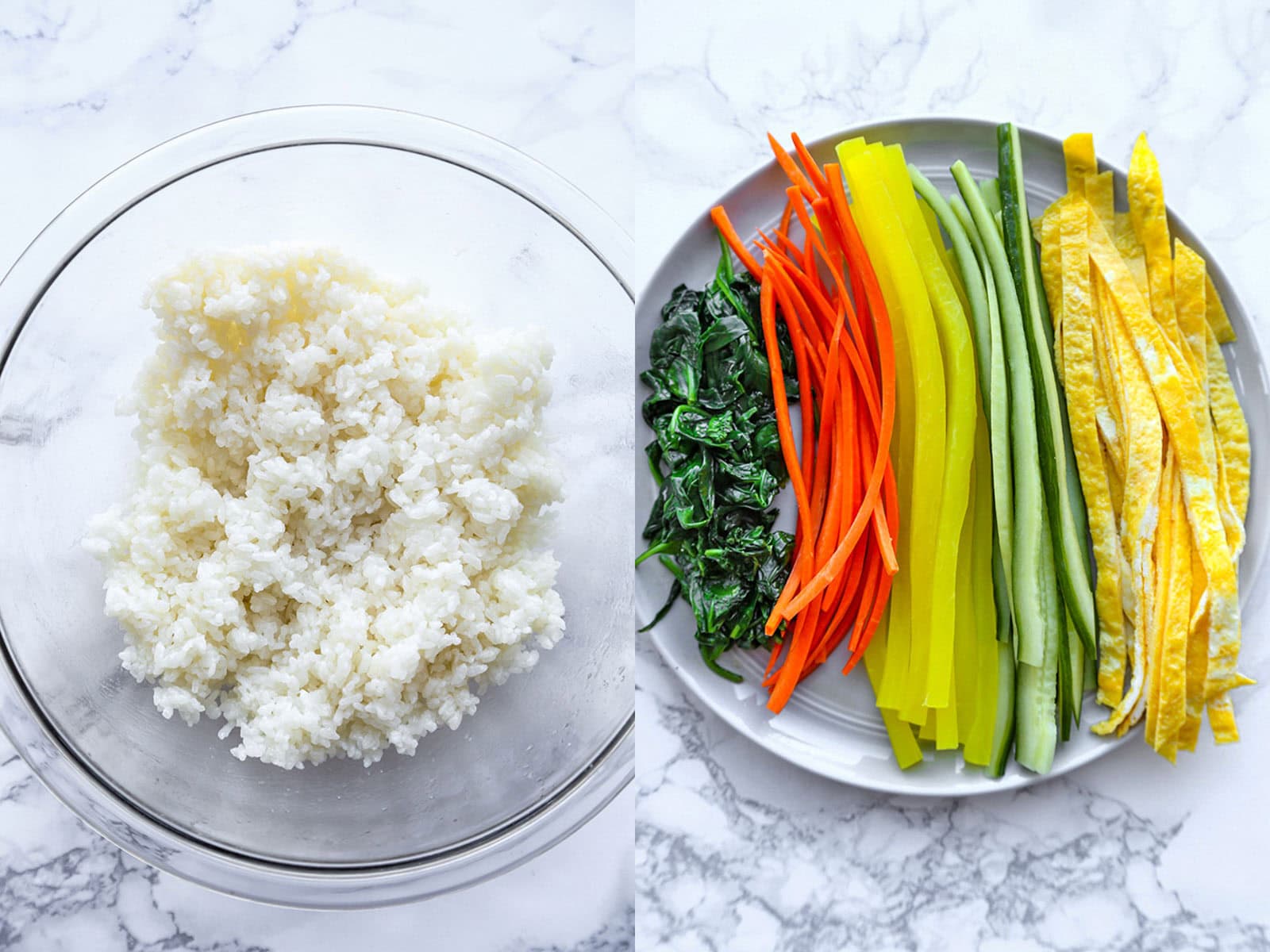
What is Kimbap?
Kimbap, or gimbap, is a Korean dish made of seasoned cooked rice and various fillings that are rolled in dried seaweed, and cut into bite size pieces. It’s a popular light lunch option for its portability and is often included as part of a packed meal. The look of kimbap may be similar to Japanese maki rolls but its components are very different.

What is the Difference Between Kimbap and Sushi?
While the basic ingredients for both kimbap and sushi rolls include rice and dried seaweed, that’s pretty much where the similarities end. Let’s start with the rice:
- Sushi rice is made with Japanese short grain rice and seasoned with rice vinegar, sugar, salt, and sometimes kombu dashi. Sushi rice has a tangy, salty, and slightly sweet taste.
- Kimbap rice is seasoned with sesame oil and has a nutty and slightly sweet taste. Short grain brown rice or black rice (fordbidden rice) can also be used to make kimbap.
Fillings
- Sushi rolls are made with raw fish, vegetables, and sometimes pickles.
- Kimbap rolls are made with a combination of vegetables, preserved foods, sometimes cheese, and proteins such as ham, beef, and egg.
Seaweed
- The seaweed on sushi rolls is served as is.
- The seaweed on kimbap is brushed with a little sesame oil.
Lastly, while sushi is perceived as a form of art, a meal to be enjoyed on special occasions, kimbap is the exact opposite. It’s usually made at home or in small shops run by home chefs and ‘aunties’, and is served at picnics or as part of a school lunch.
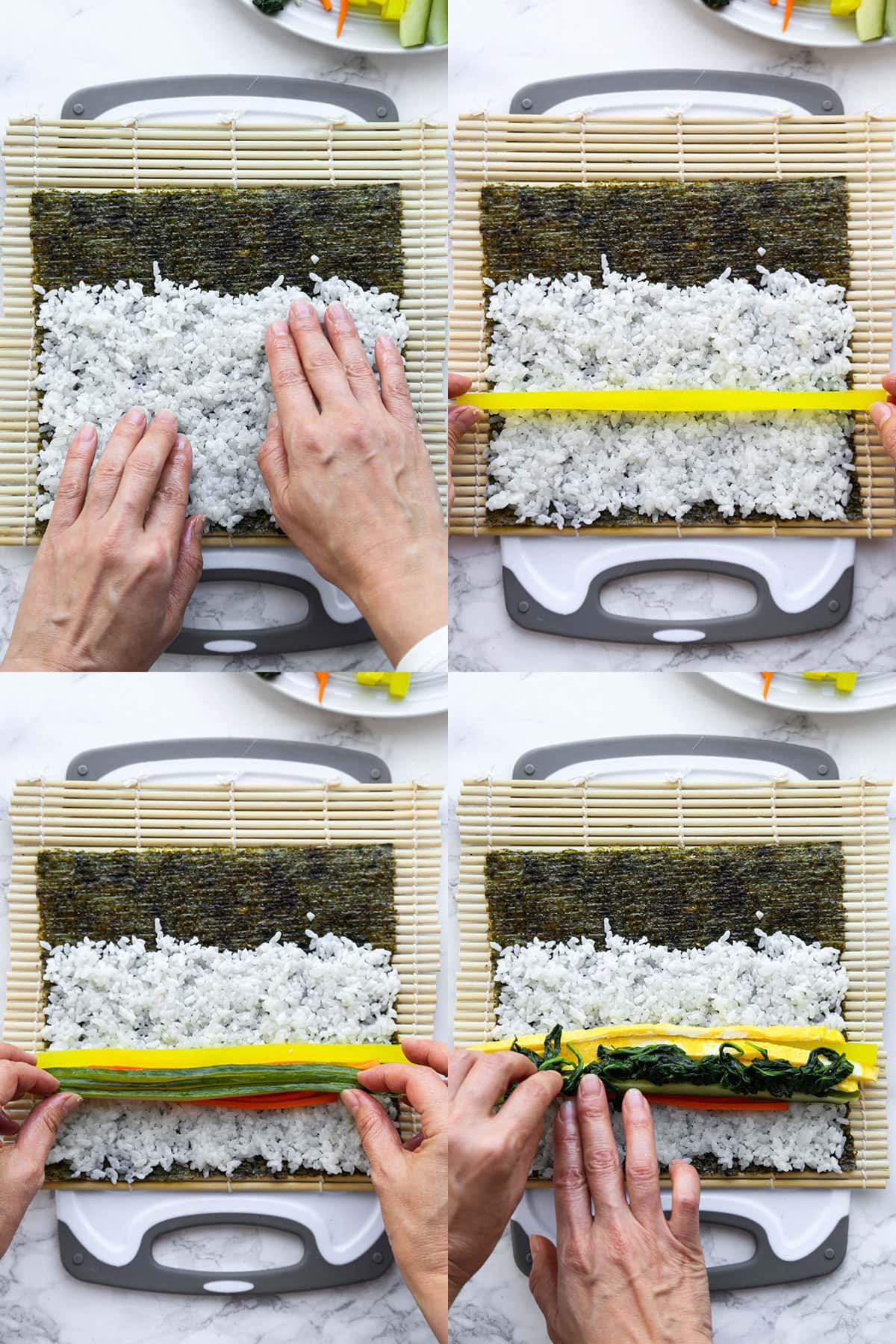
Ingredients Needed
- Rice: You can use cooked short grain Japanese rice, cooked short grain brown rice, or forbidden rice.
- Sesame oil: You will need sesame oil to make the kimbap rice, pan fry some of the fillings, season the spinach, and to brush on the seaweed.
- Seaweed: About 3 to 4 nori seaweed sheets. Make sure the dull side is facing up when you are using them.
- Filling: For this recipe you will need a carrot, danmuji (yellow pickled daikon), English cucumber, 2 large eggs, and some baby spinach.
Filling Variations
Kimbap is so versatile that you can pretty much use anything you like as a filling! But if your goal is to create rolls that contain popular filling combinations, try some of these below:
- Eomuk (fish cakes)
- Beef (bulgogi or ground beef)
- Canned tuna
- Ham
- Spam
- Imitation crab
- Kimchi
- Cheese
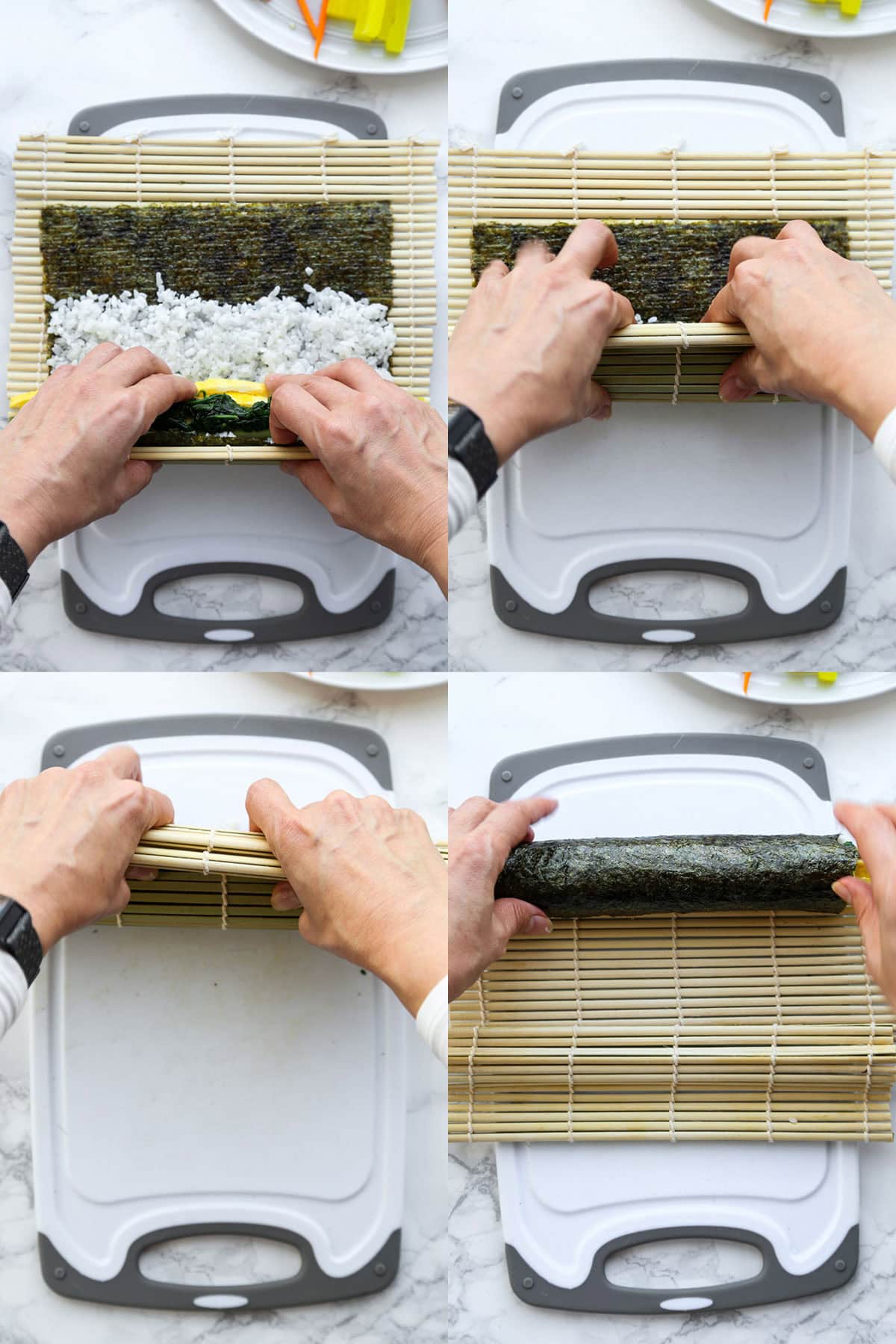
How to Make Kimbap
- Gather all of your ingredients to make kimbap.
- Start by making the rice – combine the cooked rice, sesame oil, and salt, in a bowl and use a rice paddle to mix the rice.
- Add 1 teaspoon of sesame oil to a small pan and add the whisked eggs. Swirl the pan around to create an omelette and cook until the eggs are cooked through.
- Slide the omelette on a cutting board and cut into long strips. Set aside on a plate and place the pickled daikon sticks next to the strips.
- Add another teaspoon of sesame oil to the same pan and add the carrot and cucumber sticks. Cook for 1 minute, turn the heat off, and place the vegetables next to the omelette strips.
- Fill a small pot with salted water and bring to a boil. Add the spinach and boil for 1 minute. Drain and rinse the spinach under cold water. Drain again and gently squeeze the spinach to remove excess water.
- Add the spinach to a bowl and toss it with 1 teaspoon sesame oil and a pinch of salt.

Making The Rolls
Now that all of your ingredients are prepped, it’s time to make kimbap rolls!
- Place the bamboo mat on a flat surface in front of you.
- Grab a sheet of dried seaweed and lay it flat on the bamboo mat, shiny side down.
- Place a small bowl of water next to the bamboo mat.
- Add a little sesame oil to a bowl and set it next to the bamboo mat, along with a basting brush.
- Scoop up 3/4 cup of rice and put it on the seaweed. Spread it across the sheet using your fingers, until 2/3 of the sheet is covered. Leave the section that’s furthest from you empty.
- Take a few ingredients to make your filling and add them to the center of the rice.
- Using your thumbs, hold the bottom edge of the bamboo mat (the side closest to you) and lift. Hold on to the filling with your other fingers, so they don’t fall out, and begin rolling. Roll into a tight cylinder while tucking the filling in firmly.
- Keep rolling until you get to the empty part of the seaweed. Dip a couple of fingers in water and lightly run them across the seaweed.
- Keep rolling until you reach the end of the mat and let go.
- Take the basting brush, lightly dip it in sesame oil and brush the outside of the kimbap.
- Slice the roll into bite size pieces and serve.

Best Way To Eat It
Kimbap is best eaten fresh at room temperature. That’s when the texture of the rice is at its best – moist and chewy. Refrigerating it will make the rice hard and chalky and I don’t recommend reheating it in the microwave either. The texture of the seaweed will deteriorate the longer you leave it and microwaving might make the rolls fall apart and give the kimbap a mushy texture.
However, there is a technique you can use to eat good kimbap the next day!
- Use eggs: Break 1-2 eggs in a bowl and whisk them. Slice your kimbap into bite size pieces (if it’s not sliced already) and dip each piece in egg, making sure to coat it on both sides. Add 2-3 tablespoons of oil to a pan and turn the heat to medium. When the oil is hot, add the kimbap pieces and cook on each side for 1-2 minutes, until the egg is golden brown. Transfer to a plate and serve.
To make it even more interesting, you can dip the kimbap in panko breadcrumbs after it’s been dipped egg. Cook for an additional minute or two and serve.
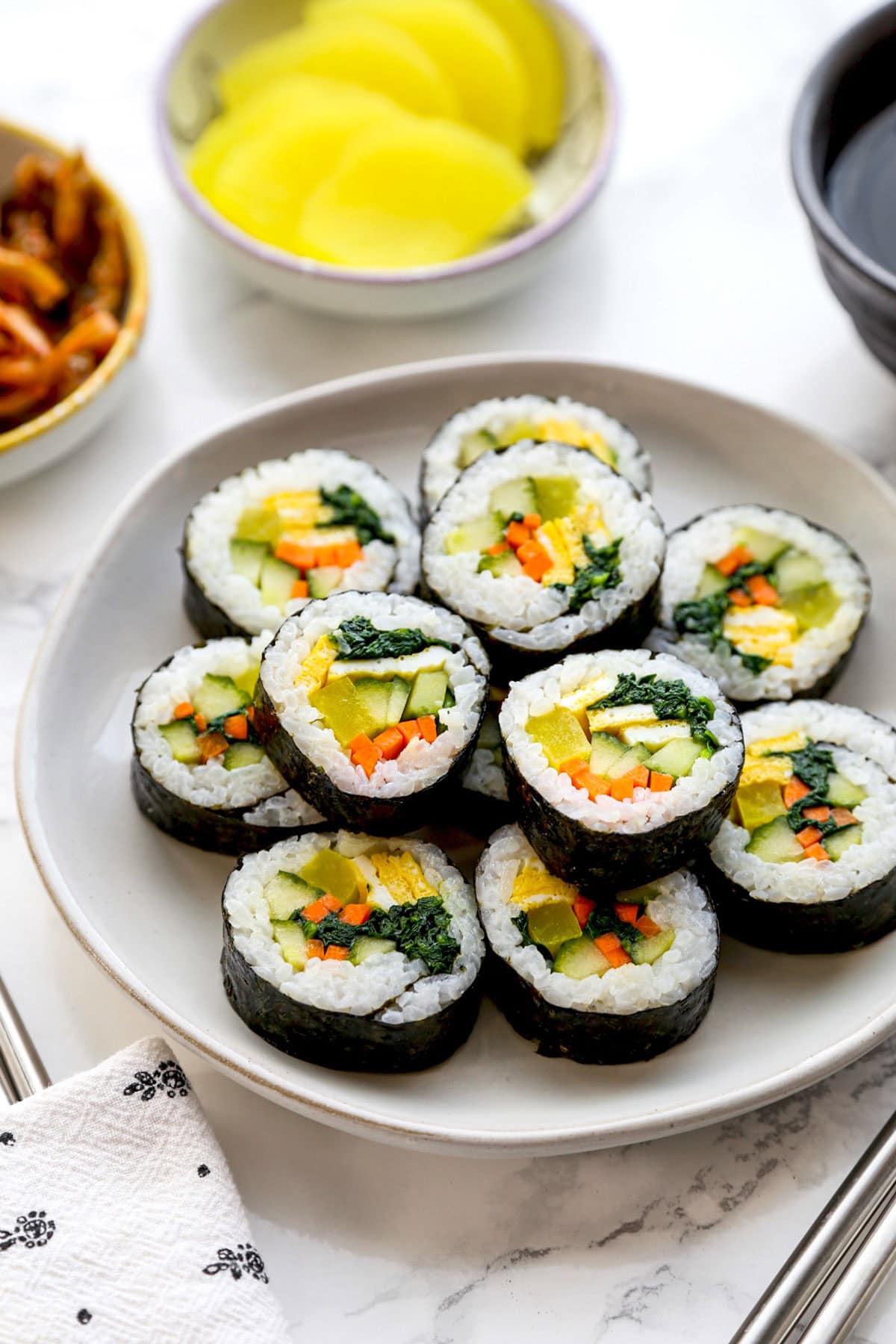
What to Serve with Kimbap
Kimbap is usually served as a side dish or a snack.
Because it’s mild in taste and not too filling, it pairs nicely with dishes that are bold and either light or hearty. To make an authentic Korean meal, I suggest serving kimbap with:
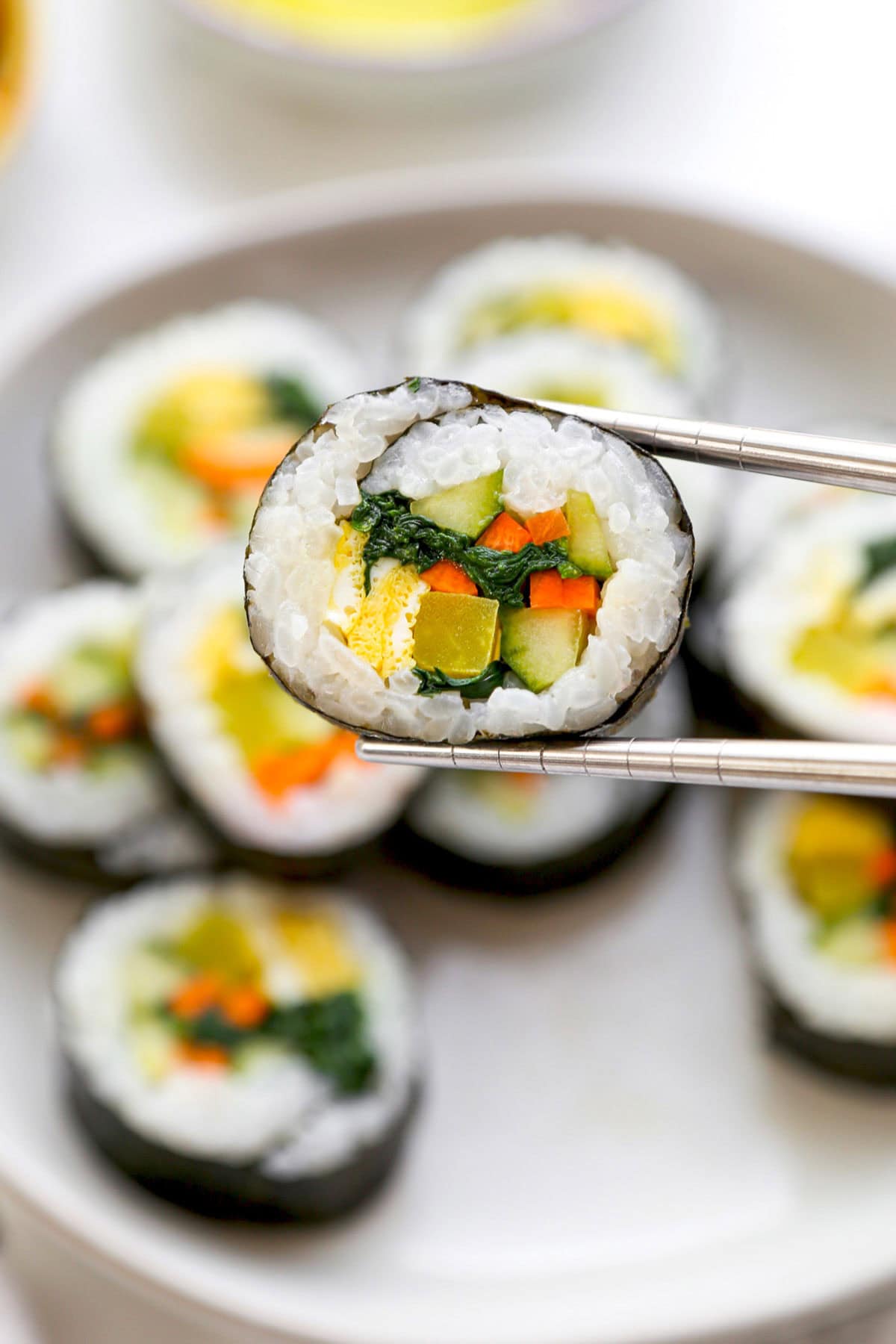
Did you like this recipe? Are there changes you made that you would like to share?
Print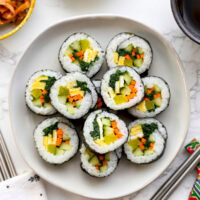
Vegetable Kimbap
- Prep Time: 25 minutes
- Cook Time: 5 minutes
- Total Time: 30 minutes
- Yield: 3–4 rolls 1x
- Category: Rice
- Method: Rolling
- Cuisine: Korean
- Diet: Vegetarian
Description
With a colorful center and sesame flavored rice, kimbap makes a delicious snack or light lunch to eat at home, school, or work!
Ingredients
- 3 cups cooked Japanese rice, room temperature
- 2 tablespoons sesame oil
- 1/2 teaspoon salt
- 3 teaspoons sesame oil
- 2 large eggs, whisked
- Danmuji (yellow pickled radish or takuan), sliced lengthwise into sticks
- 1/2 English cucumber cut lengthwise, seeds scooped out with a small spoon
- 1 medium carrot, peeled and sliced lengthwise into thin sticks
- 3 1/2 cups baby spinach
- Sesame oil, for brushing
Instructions
- Season the rice: To make the kimbap rice, place the rice in a bowl and add the sesame oil and salt. Mix using a rice paddle until the rice is evenly coated. Cover with a kitchen towel and set aside.
- Cook the eggs: In a medium pan, add 1 teaspoon sesame oil and turn the heat to medium. Add the whisked eggs and tilt the pan to spread the mixture evenly. Cook for 2-3 minutes, until the omelette if fully cooked.
- Slice the omelet: Carefully transfer the omelette to a cutting board and let cool for 1-2 minutes. Slice into sticks and place them on a large plate.
- Add the danmuji: Add the pickled daikon to the plate with the sliced omelette.
- Cook the carrot and cucumber: Using the same pan for the omelette, add the remaining 1 teaspoon sesame oil and turn the heat to medium. When the oil is hot, add the carrot and cucumber sticks and cook for 1 minute. Turn the heat off and transfer the vegetables to the plate, next to the daikon and omelette.
- Boil and season the spinach: Bring a small pot of salted water to boil and add the spinach. Boil for 1 minute and drain. Rinse the spinach under cold water and gently squeeze out the excess water. Take your time squeezing out the water, squeeze as much out as you can. Transfer the spinach to a bowl and toss with 1 teaspoon sesame oil. Season with salt and set aside.
- Place a nori sheet on bamboo mat: Place a bamboo mat on a flat surface and add a sheet of nori seaweed on top, shiny face down.
- Fill a bowl with water: Fill a small bowl with water and place it next to the bamboo mat.
- Keep a little sesame oil to the side: Add a little sesame oil to a small bowl and place it next to the bamboo mat, with a brush.
- Add rice to the nori sheet: Put about 3/4 cup of rice on the seaweed and spread it evenly across, parallel from you, leaving about 1/3 of the seaweed – the side furthest from you- empty.
- Add the fillings: Add the fillings to the center of the rice – I recommend calculating and separating the fillings equally so you have the same amount for 3-4 kimbap rolls – and start rolling.
- Make the kimbap: Grab the bottom edges of the mat with your thumbs while holding on to the filling with your other fingers. Roll it into a tight cylinder, tucking the fillings in firmly and slightly lift the edge of the bamboo mat.
- Keep rolling: Roll it forward while using a little pressure but not so much that the filling spills out.
- Seal the kimbap: Dip your index finger in water and lightly wet the part of the seaweed that’s empty.
- Finish rolling: Keep rolling and let go of the mat when you get to the other end.
- Slice the roll: Lightly brush the seaweed with some sesame oil and slice kimbap into bite size pieces. Serve immediately (kimbap tastes best fresh).
Notes
To make this kimbap vegan: Substitute the eggs for firm tofu, baked tofu, or imitation ham.
For leftover kimbap: Break 1-2 eggs in a bowl and whisk them. Slice your kimbap into bite size pieces (if it’s not sliced already) and dip each piece in egg, making sure to coat it on both sides. Add 2-3 tablespoons of oil to a pan and turn the heat to medium. When the oil is hot, add the kimbap pieces and cook on each side for 1-2 minutes, until the egg is golden brown. Transfer to a plate and serve. To make it even more interesting, you can dip the kimbap in panko breadcrumbs after it’s been dipped egg. Cook for an additional minute or two and serve.
Nutrition
- Serving Size: 1 kimbap roll
- Calories: 333
- Sugar: 2.3g
- Sodium: 837.4mg
- Fat: 13.1g
- Saturated Fat: 2.4g
- Unsaturated Fat: 4.9g
- Trans Fat: 0g
- Carbohydrates: 45.4g
- Fiber: 2g
- Protein: 7.7g
- Cholesterol: 93mg














